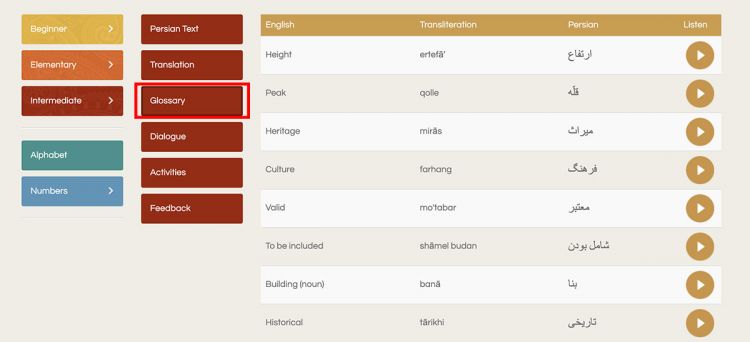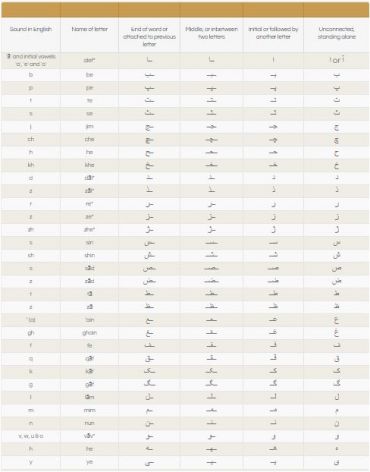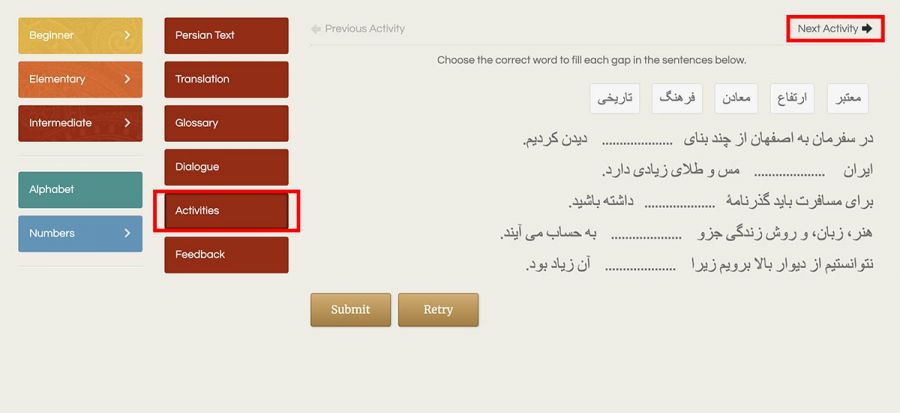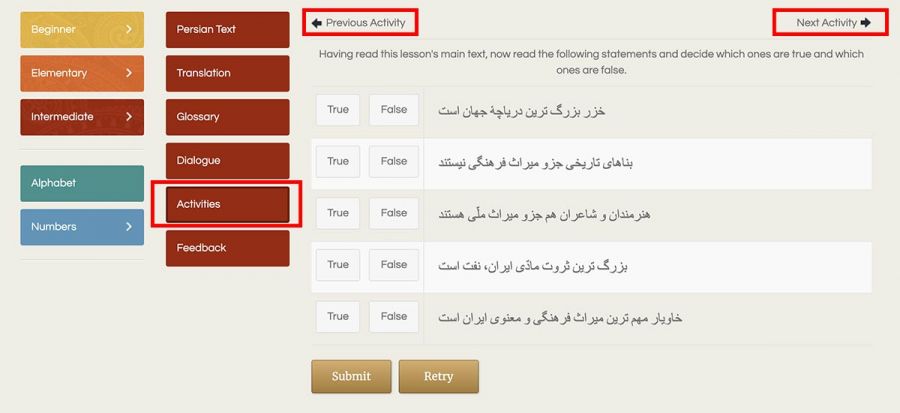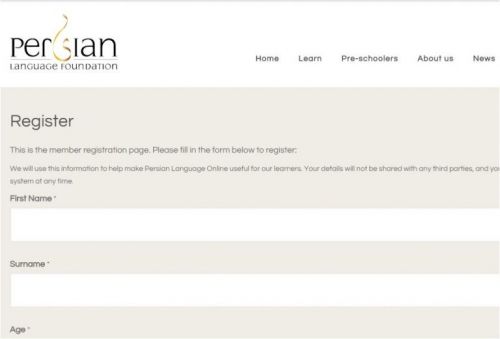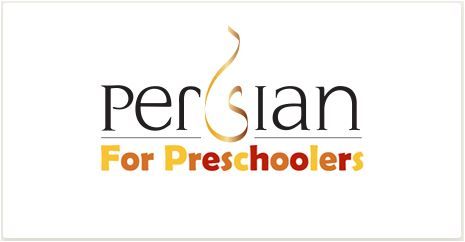
Project 6060 – Lesson 42
EN
FR
ES
FA
-
EN
Lesson 42
The Persian Language
***
Translation
Persian is the official language of Iran and Iranians speak to each other in this language. Persian is not only the language of the Iranian people, but is also the official language of Tajikistan and Afghanistan. In the past, many of the people of India and Pakistan also spoke this language.
In Iran, the people of various cities and villages speak Persian with their own specific dialects. The most prevalent Persian dialect is the Tehrani dialect, but besides that, other famous dialects such as Esfahani, Shirazi, Yazdi, Mashhadi, and so on, also exist. The standard form of this language is used in education, the news, newspapers, and official correspondence.
Throughout history, this language has been stricken with many changes and has been subject to the influence of different powers and languages in different historical eras. The Persian language of today is the remnant of the Ancient Persian language, which existed in the time of the Achaemenids and was written in the cuneiform script, and then changed to Middle Persian, which was written in the Pahlavi script. Since Islam, Middle Persian changed to Modern Persian.
The Modern Persian alphabet is taken from the Arabic alphabet, has 32 letters and is written from right to left. This script is more than one thousand, one hundred years old and its calligraphy is an Iranian art, called ‘khosh nevisi’.
Throughout history, many efforts have been undertaken to keep the Persian language alive. Many Iranian and non-Iranian writers and poets have written books and composed poetry in this language and today, as a result of these struggles, the Persian language possesses a wealth of literature. These poets and writers are famous throughout the world. Ferdowsi’s Shahname, Mowlana’s Masnavi, Sa’di’s Golestan and Bustan, Khayyam’s Rubaiyat, Hafez’ Divan and the Kelileh va Demneh are some of the most famous Persian literary works.
-
FR
Leçon 42
La langue persane
***
Traduction
Coming soon
-
ES
Lección 42
El idioma persa
***
Traducción
Coming soon
-
FA
درس چهل و دو
زبان فارسی
***
متن فارسی
فارسی زبان رسمی ایران است و ایرانیان به این زبان با هم صحبت می کنند. فارسی تنها زبان مردم ایران نیست، بلکه در کشورهای تاجیکستان و افغانستان هم زبان رسمی است. بسیاری از مردم هند و پاکستان نیز در گذشته به این زبان حرف می زدند.
در ایران، مردم شهرها و روستاهای مختلف زبان فارسی را با لهجۀ خاص خودشان حرف می زنند. رایج ترین لهجۀ فارسی، لهجۀ تهرانی است، امّا به جز آن، لهجه های معروف دیگری مانند اصفهانی، شیرازی، یزدی، مشهدی و غیره نیز وجود دارد. گونۀ معیار و استاندارد این زبان در آموزش، اخبار، روزنامه ها و مکاتبات اداری استفاده می شود.
در طول تاریخ این زبان دچار تغییرات زیادی شده است و در دوره های مختلف تاریخی تحتِ تاثیر قدرت ها و زبان های مختلف قرار گرفته است. زبان فارسی امروز بازماندۀ زبان فارسی باستان است که در زمان هخامنشیان وجود داشت و به خط میخی بود و سپس به فارسی میانه تغییر پیدا کرد که به خط پهلوی نوشته می شد. زبان فارسی میانه بعد از اسلام به زبان فارسی نو و امروزی تغییر یافت.
الفبای زبان فارسی نو برگرفته از الفبای عربی است و 32 حرف دارد و آن را از راست به چپ می نویسند. عمر این خط بیش از هزار و صد سال است و زیبا نوشتن آن یکی از هنرهای ایرانی است که خوش نویسی نام دارد.
در طول تاریخ، تلاش های فراوانی برای زنده نگه داشتن زبان فارسی انجام شده است. نویسندگان و شاعران ایرانی و غیر ایرانی بسیاری به این زبان کتاب نوشته اند و شعر سروده اند و در نتیجۀ این تلاش ها امروزه زبان فارسی از ادبیات غنی برخوردار است. این شاعران و نویسندگان در دنیا مشهورند. شاهنامۀ فردوسی، مثنوی مولوی، گلستان و بوستان سعدی، رباعیات خیّام، دیوان حافظ، و کلیله و دمنه از معروف ترین آثار ادبی فارسی هستند.
DIALOGUE
DIALOGUE
DIÁLOGO
مُکالِمه
-
EN
Translation of Dialogue
Maryam: What languages do you know other than Persian?
Bahman: English, Arabic and French
Maryam: Where do they speak Persian, other than Iran?
Bahman: Afghanistan and Tajikistan. Do you know French too?
Maryam: Very little. But I’d like to learn.
Bahman: You need to go to a class.
Maryam: I can learn from reading books and newspapers and watching films too.
Bahman: They’ll help you a lot, but you’ll learn more in a class. -
FR
Traduction de Dialogue
Coming soon
-
ES
Traducción de Diálogo
Coming soon
-
FA
متن فارسی مُکالمه
مریم: به جز فارسی چه زبونی بلدی؟
بهمن: انگلیسی، عربی و فرانسوی.
مریم: به جز ایران دیگه کجا فارسی صحبت می کنن؟
بهمن: افغانستان و تاجیکستان. تو هم فرانسوی بلدی؟
مریم: خیلی کم. ولی دوست دارم یاد بگیرم.
بهمن: باید کلاس بری.
مریم: می تونم با خوندن کتاب و روزنامه و دیدن فیلمم یاد بگیرم.
بهمن: اونا خیلی بهت کمک می کنه، امّا تو کلاس بیشتر یاد می گیری.

